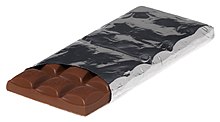Candy bar

A candy bar is a type of candy that is in the shape of a bar. The most common type of candy bar is the chocolate bar,[citation needed] including both bars made of solid chocolate and combination candy bars, which are candy bars that combine chocolate with other ingredients, such as nuts, caramel, nougat, or wafers.
Many varieties of candy bars exist,[1][2] and many are mass-produced.[3][4] Between World War I and the middle of the 20th century, approximately 40,000 brands of candy bars were introduced.[5][6]
Chocolate bars[]

A chocolate bar is a bar-shaped piece of chocolate, which may also contain layerings or mixtures of other ingredients. A wide variety of chocolate bar brands are sold. A popular example is a Snickers bar, which consists of nougat mixed with caramel and peanuts.

The first solid chocolate bar was produced by Fry's of Bristol, England in 1847. Fry's Chocolate Cream became the first mass-produced chocolate bar in 1866.[7] The Goo Goo Cluster was the first mass-produced combination bar, including marshmallow, nougat, caramel, and roasted peanuts.[8] In some varieties of English and food labeling standards, the term chocolate bar is reserved for bars of solid chocolate, with candy bar used for products with additional ingredients.
Non-chocolate bars[]

Candy bars containing no chocolate include:
- Abba-Zaba – taffy with a peanut butter center
- AirHeads - a taffy based candy that comes in multiple flavours
- Big Hunk - nougat center covered with peanuts
- Bit-O-Honey – honey-flavored taffy with almond bits
- Carambar - caramel-based candy
- Caramac - caramel-based candy
- Chick-O-Stick - peanut butter center covered with coconut
- Choo Choo Bar - liquorice-based candy
- Laffy Taffy - a taffy based candy that comes in multiple flavours
- Mantecol - a peanut butter nougat bar
- Munch - peanut brittle-like candy
- PayDay – peanuts and caramel
- Salted Nut Roll - nougat center covered with caramel and peanuts
- Turkish Taffy - taffy-based candy
- Wazoo - taffy center covered with sprinkles
- Zagnut – peanut brittle wrapped in toasted coconut
Further reading[]
- Mazze, Edward M. and Michman, Ronald D., The Food Industry Wars: Marketing Triumphs and Blunders (Praeger, 1998)
- Cadbury, Deborah, Chocolate Wars: The 150-Year Rivalry Between the World's Greatest Chocolate Makers (PublicAffairs, 2011)
See also[]
- Candy making
- Dessert bar – a type of American "bar cookie"
- Energy bar
- Granola bar
- Yeot-gangjeong
- List of candies
References[]
- ^ Hand-Crafted Candy Bars - Susie Norris, Susan Heeger. p. 13.
- ^ Nutrition - Paul Insel, Don Ross, Kimberley McMahon, Melissa Bernstein
- ^ Kiplinger's Personal Finance. p. 20.
- ^ Business Builders In Sweets and Treats - Nathan Aaseng. p. 28.
- ^ Hand-Crafted Candy Bars - Susie Norris, Susan Heeger. p. 13.
- ^ Insel, Paul; Ross, Don; McMahon, Kimberley; Bernstein, Melissa (2010-04-07). Nutrition. Jones & Bartlett Publishers. ISBN 9780763793760.
- ^ Mintz, Sidney (2015). The Oxford Companion to Sugar and Sweets. Oxford University Press. p. 157.
- ^ Kawash, Samira (2013). Candy: A Century of Panic and Pleasure. Faber and Faber. pp. 152–153, 156–157, 163. ISBN 9780374711108.
External links[]
 Media related to Candy bars at Wikimedia Commons
Media related to Candy bars at Wikimedia Commons
- Candy bars
- Confectionery